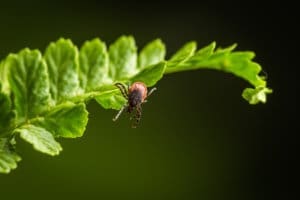Ticks are a dangerous vector insect species found in many parts of the United States. They require an animal host to survive and reproduce and feed on the host animal’s blood. Ticks live in shady areas near the ground level. They do not jump or fly; instead, ticks will cling to the edge of a blade of grass or shrub with their back legs and leave the front outstretched to cling onto an animal passing by.
 When the tick begins to feed on the host animal, saliva from the tick is passed to the host animal. If the tick is carrying a disease, the disease can be transmitted through this process. One such dangerous disease that is becoming more prevalent in Oregon is Lyme disease. Because of the dangers ticks present, it’s essential for homeowners to use proper techniques for preventing ticks in yards.
When the tick begins to feed on the host animal, saliva from the tick is passed to the host animal. If the tick is carrying a disease, the disease can be transmitted through this process. One such dangerous disease that is becoming more prevalent in Oregon is Lyme disease. Because of the dangers ticks present, it’s essential for homeowners to use proper techniques for preventing ticks in yards.
What types of environments attract ticks?
There are many types of ticks in Oregon, but the most common ticks to spread Lyme disease are the black-legged tick (or “deer tick”) and the western black-legged tick. These ticks are abundant in wooded and forested areas–an environment very common to many regions of our state. However, they can also be found in lawns and shrubs of residential areas. If wildlife such as deer, squirrels, mice, or rats are common to an area, they may be carrying and transporting ticks.
What are some techniques for preventing ticks in yards?
The good news is there are several ways homeowners can create a tick-free zone around their homes. Even with these techniques in place, it is still important to regularly examine the body for ticks and to keep pets on appropriate tick prevention medication.
- Keep the grass around the home mowed.
- Remove standing debris like leaves, brush, and weeds in and around the lawn.
- Limit the placement of ground covers near areas where pets and humans will be.
- Remove brush and leaves around fences, stonewalls, wood piles, and other structures.
- Use pest control mitigation to reduce the population of mice, rats, and other animals in the yard.
- Move firewood piles and bird feeders away from the home.
- Don’t allow pets to roam in wooded or forested areas.
- Avoid planting flowers or shrubs that attract deer.
- Place children’s play equipment on wood chips or mulch far away from wooded areas.
- Keep tree branches and shrubs trimmed to allow more light (ticks prefer shade.)
- Use landscaping materials that prevent moisture, such as gravel pathways and mulches.
- Construct a 3-foot or wider wood chip, mulch, or gravel border between the lawn and wooded areas.
For more information about tick prevention and treatment, visit JCVCD.org.
The Jackson County Vector Control District (JCVCD) serves all Jackson County, Oregon residents. The organization is dedicated to providing information and free resources to help citizens mitigate the risks created by vector species in Southern Oregon. You can find more information at jcvcd.gov or by signing up for free notifications at this link: https://jcvcd.gov/subscribe-notification-list/
